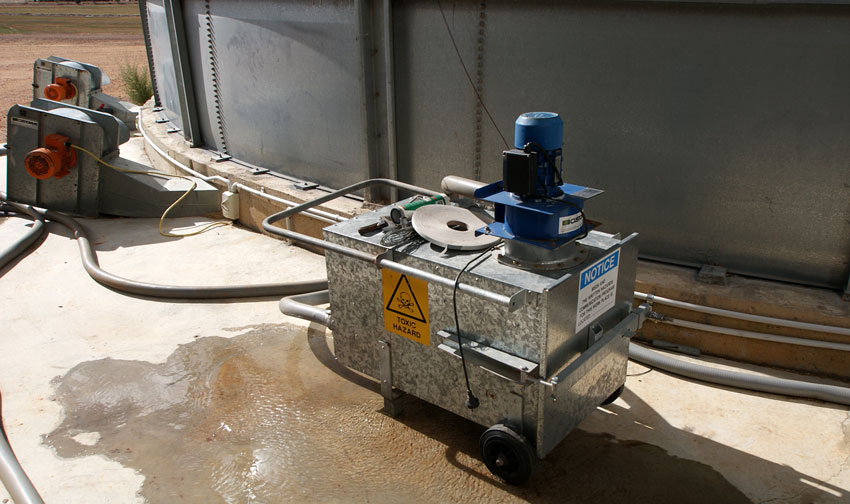Key message
- Ground-level fumigation systems are safer for users, but phosphine can be explosive, so precautions are needed to ensure a safe and effective fumigation.
Phosphine fumigation can now be completed using ground-level application systems, which are much safer as the user does not need to climb to the top of the silo. But some key features and precautions are needed for successful and safe fumigation:
- recirculation;
- space for liberation;
- condensation trap; and
- pressure relief for power outage.
Phosphine needs space to disperse safely. For ground-level application, a recirculation system is essential to improve the rate of phosphine flow through the silo and prevent explosion in the confined application chamber.
Without airflow, phosphine moves through grain at roughly six metres per 24 hours, according to Queensland Department of Agriculture and Fisheries research. This means it could take several days for gas concentrations to reach lethal levels in all parts of a large silo. A sealed recirculation system will transfer air from the head space in the top of the silo back to the bottom of the silo, or vice versa, to reduce the time taken.
Recirculation systems
There are two types of recirculation – active (powered) or passive (thermosiphon).
Active systems include a powered fan to move air in the closed loop system. Passive recirculation relies on thermal currents to transfer air through pipes up the outside of silos, often referred to as thermosiphons. Active or powered recirculation is necessary for silos larger than 150 tonnes and is the preferred option for smaller silos.
A key criterion for recirculation is that the plumbing does not compromise the sealability of the silo, now or into the future. This requires quality pipe with solid fittings and mounts.

Powered recirculation systems produce even gas distribution in large, flat-bottom silos, avoiding areas of sub-lethal gas concentrations. Photo: Chris Warrick
For passive or thermosiphons, the pipe size needs to be large. Research commissioned by the Council of Grain Grower Organisations found that a 90-millimetre thermosiphon pipe on a 6m-high silo moved 1800 litres of air per 24 hours. Any restriction through pipe fittings, transitions or smaller pipe is inadequate for ground-level application.
As phosphine liberates (changes from a solid to a gas) the concentration can reach explosive levels in a confined space. This is exacerbated during humid weather, if the grain in the silo is high in moisture, or moisture is added to or near the phosphine – an unnecessary and extremely dangerous practice.
To improve safety, maximise both the space for phosphine to liberate and the airflow in the sealed system to carry gas out of the application chamber and into the silo.
Safety first
Condensation will inevitably run down the inside of the recirculation pipe. Ground-level application chambers should be positioned off to the side of the main vertical pipe to enable condensation to run past the chamber, where it can be drained after the fumigation is complete. If condensation runs on to the phosphine it will liberate too quickly, potentially reaching explosive levels, and lead to a short period of high gas concentration rather than a sustained period of the required gas concentration.
While the application chamber in a thermosiphon needs to be positioned to the side of the vertical pipe, the pipe connecting it to the bottom of the silo needs to be on the opposite side of the chamber to ensure airflow goes through, rather than past, the chamber.
If power is cut to active or powered recirculation systems during a fumigation, gas concentration in the chamber could soon reach explosive levels. These systems require an uninterruptable power supply and a safety pressure relief to ensure that, if the application chamber does explode, it does so in a way that does not involve steel fragments flying in all directions.
More information: Chris Warrick, 1800 WEEVIL, info@storedgrain.com.au























































